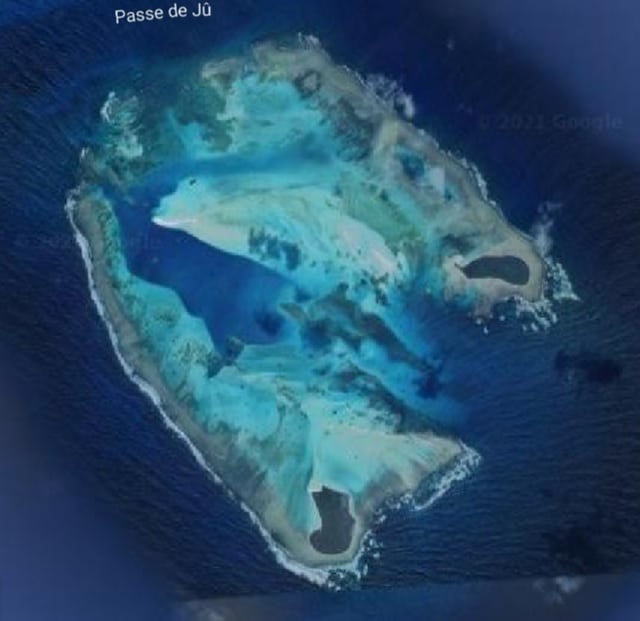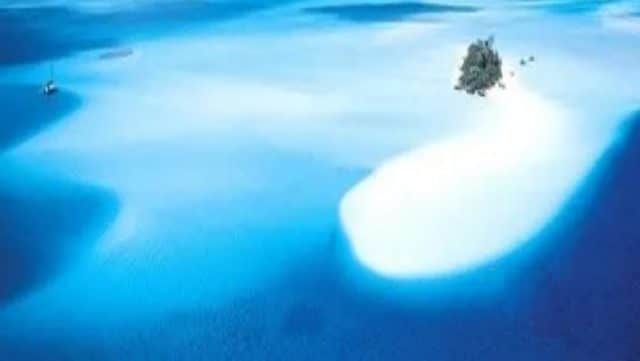

Coral atolls are one of the most amazing features in Nature. They mark the remains of ancient volcanos that long ago sank below the waves, leaving a ring of coral growing upwards to the surface. Due to the action of rainwater some of these atolls have a pass on their leeward side through which boats may enter into a calm lagoon within. A welcome opportunity on a long passage.
There are about 440 coral atolls on earth. Extremely rare considering the size of the oceans. Of these only a few are accessible by boat. Sailing the Lazy Bones we visited Nokanhui Atoll (above) and Palymra Atoll (Gilligan’s Island). Our visit to Nokanhui Atoll was quite the adventure. We anchored in the blue hole off Kutomërë Island and we had the atoll all to ourselves. We might still be there if the weather hadn’t forced us back to Isle of Pines and on to Australia.
Captain’s Log: Nokanhui Atoll was one of the more difficult locations we visited. We had been told it was an easy entrance, but when we arrived this proved not the case. There were two potential passes, and it is very difficult to see coral before you hit it. As we edged closer to the more likely pass the tide flowing into the atoll grabbed us without warning. Even in full reverse we shot into the lagoon, passing over 3 massive coral formations along the way. In the clear water it looked impossible that we would clear the coral as it passed under our keel but we did.
Once inside anchoring proved quite a challenge, as the lagoon was deep with little room to swing at anchor. We anchored with the prevailing trades and had a great time roaring around the calm water of the atoll in our dinghy, exploring the motus (islets) and re-confirming the entrance in preparation for eventual departure. Lucky we did because Mother Nature had another surprise in store for us.
We routinely got our weather reports from High Seas Weather, US Coast Guard Hawaii. When we departed for Nokanhui Atoll the weather forecast had been favorable, and so it remained during our stay. However, by then we had been sailing offshore for many years and had developed a sixth sense for weather, as our lives depended upon it. And that night I had woken up from a sound sleep feeling something was wrong. I went up on deck but there was no moon and couldn’t see anything out of order.
Returning below I went back to bed but the feeling persisted and I couldn’t sleep. Back up on deck I shone a light down into the water under the boat and got one of the biggest shocks of my life. We were standing high and dry on a sand bank balanced on our keel! Our hull was a good 4 or 5 feet out of the water. During the night the normally reliable trades had swung, carrying us over a shoal in the narrow lagoon.
However, there was nothing to be done. Without a moon it would be dangerous working in the dark and in case, should the boat fall the safest location would be below in a bunk. Our keel was 20 feet long and 14 inches wide at the base, filled with 3 tons of lead at the lowest point, which apparently was sufficient to hold us vertical on the sand. So with nothing left to do I went back to bed. But not for long.
Having just gotten back to sleep the wind again shifted and increased in strength. In doing so, the force on the boat was from the side and with the added leverage of the mast we fell over. Everything inside the boat that wasn’t nailed down shot across the boat and ended up on starboard side. It was surprising because none of this had ever let go previously in the roughest of conditions. Luckily our steel hull was not affected. Our previous fiberglass yacht had developed numerous stress fractures from a fall of only a few inches onto sand.
A quick survey showed no one was injured. Pillows and cushions were stacked against the walls and everyone returned to a not too peaceful sleep until sunrise. Eventually the rising tide floated us off and the wind shift carried us back into deep water. A cleanup and more complete survey showed all was in order.
The wind shift however bothered me. During the day the wind continued variable and a low scud began to form overhead along with a steep rise in humidity. The sort of weather that made the hair stand up on the back of my neck. Checking the tide tables and distance back to Isle of Pines we had a window in the early afternoon to get out through the pass at slack high water that would allow us to arrive Isle of Pines by sunset. Checking with High Seas Weather they had nothing forecast, but their forecast didn’t match my local observations.
So we pulled the plug. Anchor up we motored out through the pass under main, then raised the headsail for Isle of Pines. And had a wonderful sail back and rounding the point into the anchorage got another shock. In what had been a busy anchorage with perhaps 2 dozen yachts at anchor, not a single boat remained. Like something out of the Twilight Zone, post apocalypse. Only later did we learn that a weather alert had been broadcast in French but we were not monitoring the French channels. The English weather broadcast were still calling for fine conditions.
As it was late in the day and had no idea what had happened we had no option but to anchor. And it began to blow. And then blow some more. And then some more. We were in full on gale conditions sitting at anchor surrounded by low lying hills in a well protected location. And that night we had radio contact with two yachts enroute from Fiji to New Caledonia caught out in the gale. Both were in considerable distress and one had lost their steering. We relayed their distress calls to US Coast Guard along with a weather advisory that their high seas forecast was wrong.
Conditions worsened during the night and by early morning the wind had reached the point where we were dragging our anchor. We set a second anchor to form a V headed into the wind, with us at the point of the V. This prevents the boat from veering side to side and thus loosening a single anchor. We stopped dragging and spent the day and night in continued strong gale conditions.
On the morning of the second day the wind dropped back to normal trade winds conditions. We had heard of clear weather gales but this was the first time we had experienced one in the tropics. Ironically High Seas Weather from Hawaii broadcast a high wind warning for our area that morning. Normally spot on in their forecasts they had missed that one.